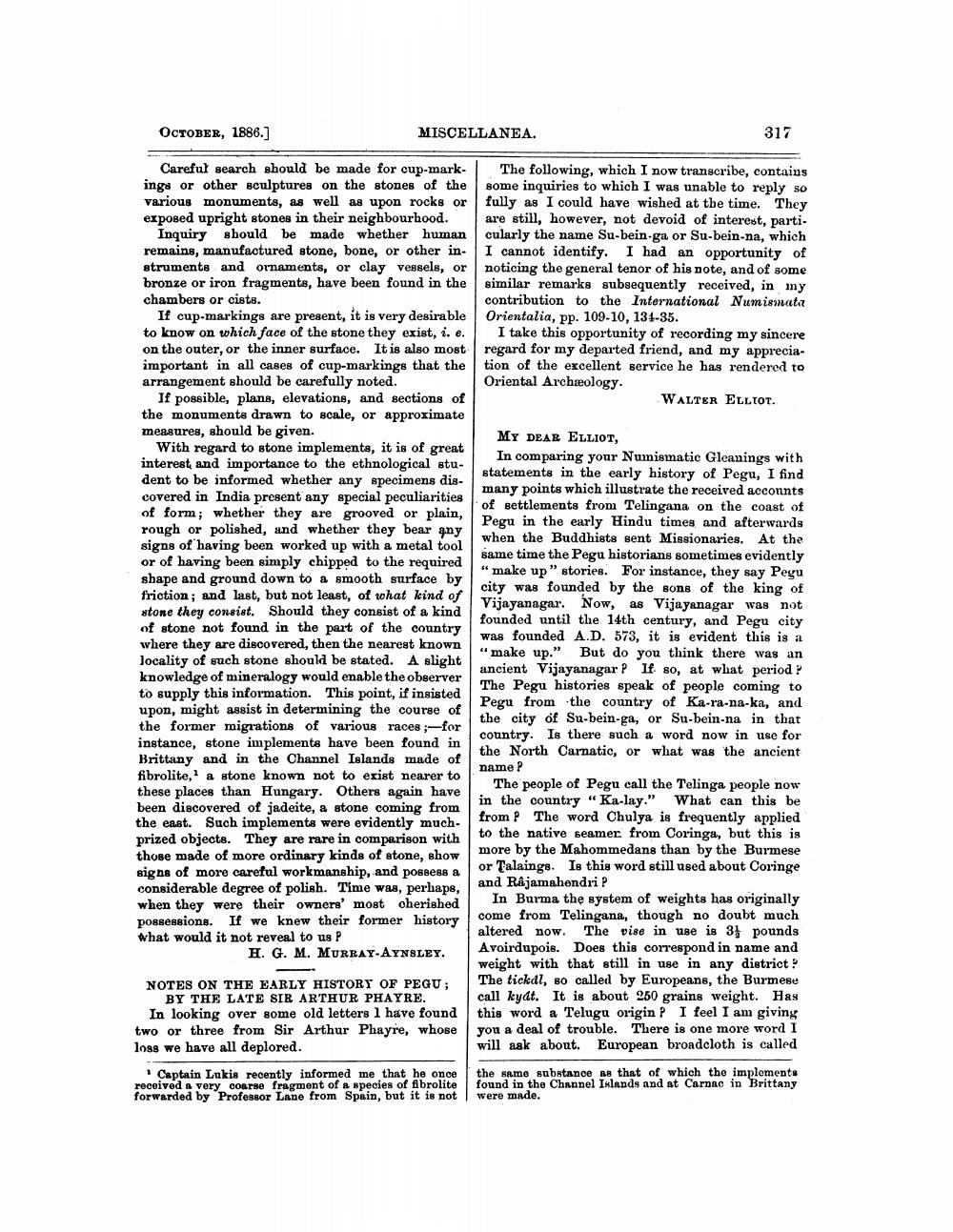________________
OCTOBER, 1886.]
MISCELLANEA.
317
Careful search should be made for cup-mark. The following, which I now transcribe, contains ings or other sculptures on the stones of the some inquiries to which I was unable to reply so various monuments, as well as upon rocks or fully as I could have wished at the time. They exposed upright stones in their neighbourhood. are still, however, not devoid of interest, parti.
Inquiry should be made whether human cularly the name Su-bein-ga or Su-bein-na, which remains, manufactured stone, bone, or other in- I cannot identify. I had an opportunity of struments and ornaments, or clay vessels, or noticing the general tenor of his pote, and of some bronze or iron fragments, have been found in the similar remarks subsequently received, in my chambers or cists.
contribution to the International Numismata If cup-markings are present, it is very desirable Orientalia, pp. 109-10, 134-35. to know on which face of the stone they exist, i. e. I take this opportunity of recording my sincere on the outer, or the inner surface. It is also most regard for my departed friend, and my appreciaimportant in all cases of cup-markings that the tion of the excellent service he has rendered to arrangement should be carefully noted.
Oriental Archäology. If possible, plans, elevations, and sections of
WALTER ELLTOT. the monuments drawn to scale, or approximate measures, should be given.
MY DEAR ELLIOT, With regard to stone implements, it is of great
In comparing your Numismatic Gleanings with interest and importance to the ethnological student to be informed whether any specimens dis
statements in the early history of Pegu, I find
many points which illustrate the received accounts covered in India present any special peculiarities
of settlements from Telingana on the coast of of form; whether they are grooved or plain,
Pegu in the early Hindu times and afterwards rough or polished, and whether they bear any
when the Buddhists sent Missionaries. At the signs of having been worked up with a metal tool
same time the Pegu historians sometimes evidently or of having been simply chipped to the required
"make up" stories. For instance, they say Pegu shape and ground down to a smooth surface by
city was founded by the sons of the king of friction; and last, but not least, of what kind of
Vijayanagar. Now, as Vijayanagar was not stone they consist. Should they consist of a kind
founded until the 14th century, and Pegu city of stone not found in the part of the country
was founded A.D. 573, it is evident this is a where they are discovered, then the nearest known
"make up." But do you think there was an locality of such stone should be stated. A slight
ancient Vijayanagar? knowledge of mineralogy would enable the observer
If so, at what period ?
The Pegu histories speak of people coming to to supply this information. This point, if insisted
Pegu from the country of Ka-ra-na-ka, and upon, might assist in determining the course of
the city of Su-bein-ga, or Su-bein-na in that the former migrations of various races for
country. Is there such a word now in use for instance, stone implements have been found in
the North Carnatic, or what was the ancient Brittany and in the Channel Islands made of
name? fibrolite, a stone known not to exist nearer to these places than Hungary. Others again have
The people of Pegu call the Telinga people now been discovered of jadeite, a stone coming from
in the country "Ka-lay." What can this be the east. Such implements were evidently much
from P The word Chulya is frequently applied prized objects. They are rare in comparison with
to the native seamer from Coringa, but this is those made of more ordinary kinds of stone, show
more by the Mahommedans than by the Burmese
or Talaings. Is this word still used about Coringe signs of more careful workmanship, and possess a considerable degree of polish. Time was, perhaps,
and Rajamahendri ? when they were their owners' most cherished
In Burma the system of weights has originally
come from Telingana, though no doubt much possessions. If we knew their former history what would it not reveal to us P
altered now. The vise in use is 3 pounds H. G. M. MURRAY-AYNSLEY.
Avoirdupois. Does this correspond in name and
weight with that still in use in any district NOTES ON THE EARLY HISTORY OF PEGU; The tickdl, so called by Europeans, the Burmese
BY THE LATE SIR ARTHUR PHAYRE. call kyat. It is about 250 grains weight. Has In looking over some old letters I have found this word a Telugu origin? I feel I am giving two or three from Sir Arthur Phayre, whose you a deal of trouble. There is one more word I loss we have all deplored.
will ask about. European broadcloth is called * Captain Lukis recently informed me that he once l the same substance as that of which the implements received a very coarse fragment of a species of fibrolite found in the Channel Islands and at Carnac in Brittany forwarded by Professor Lane from Spain, but it is not were made.




